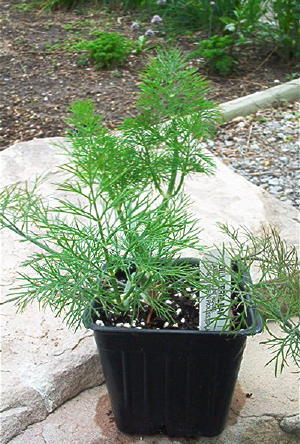Untitled Document
Name:
Dill-Fernleaf
Botanical
Name: Anethum graveolens
Zone:
N/A
Bloom
Time:
Soil:
well-drained, moderately rich, moist soil
Exposure:
Full Sun
Description:
Fernleaf or dwarf dill grows to 18" high. It has
dark green leaves. It is slow to bolt and is grown especially for its leaves
rather than its seed. It is a unique dwarf that was developed for container
culture. If you are growing dill for its seed, choose the variety called 'Bouquet'.
Dill is an annual that looks a lot like fennel, its relative. It has a single,
spindly taproot like carrot. One long, hollow stalk comes from the root. Numerous,
small, yellow flowers appear on an umbrella-like head.
Harvest
and Use: Dill is used as a medicinal, a culinary, and
in crafts. The flowerheads dry very well and add a nice, airy touch to herb
and flower arrangements. Leaves and seeds are still used to dispel wind, to
stimulate the flow of mother's milk, and to treat congestion in the breast caused
by nursing. It is still used to increase appetite, settle the stomach, and to
relieve colic in babies. In cooking, dill is delicious with fish, especially
salmon, lamb, pork, poultry, cheese, cream, eggs, cabbage, onions, cauliflower,
parsnips, squash, eggplant, spinach, potatoes, broccoli, turnips, cucumbers,
carrots, green beans, tomatoes, avocados, and apples. It is particularly popular
in salads, soups, sauces, spreads, and fish recipes of Russia and Scandinavia.
When preparing fresh dillweed, snip with scissors rather than ripping it with
a knife to avoid losing essential oils.
In
cooking, dill is delicious with fish, especially salmon, lamb, pork, poultry,
cheese, cream, eggs, cabbage, onions, cauliflower, parsnips, squash, eggplant,
spinach, potatoes, broccoli, turnips, cucumbers, carrots, green beans, tomatoes,
avocados, and apples. It is particularly popular in salads, soups, sauces, spreads,
and fish recipes of Russia and Scandinavia. When preparing fresh dillweed, snip
with scissors rather than ripping it with a knife to avoid losing essential
oils.
Harvest
by clipping leaves close to the stem in early morning or in the evening as soon
as the plant is well-established. Once harvested, it has a rather short life-span.
It can be dried but it does lose some of its flavor. Spread it on a non-metallic
screen in a warm, dark, dry place with good air circulation. Store in an air-tight
container in a cool, dry, dark spot. You can also freeze fresh picked dillweed.
Freeze it on the stems, as it is easier to handle. Just snip off what is needed
and return the rest to the freezer.
ze
fresh picked dillweed. Freeze it on the stems, as it is easier to handle. Just
snip off what is needed and return the rest to the freezer.
Care:
This annual needs full sun and
the more you harvest it's leaves the more it will produce and the longer it
will keep from going to seed. I find Fern leaf dill the best for pots, as it
doesn't flop over in the wind. Dill will disappear when the temperature dips
below freezing. If you've left some of the plant go to seed it will probably
return next year.

